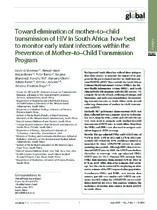| dc.contributor.author | Sherman, Gayle G. | |
| dc.contributor.author | Mazanderani, Ahmad Haeri | |
| dc.contributor.author | Barron, Peter | |
| dc.contributor.author | Bhardwaj, Sanjana | |
| dc.contributor.author | Niit, Ronelle | |
| dc.contributor.author | Okobi, Margaret | |
| dc.contributor.author | Puren, Adrian | |
| dc.contributor.author | Jackson, Debra J. | |
| dc.contributor.author | Goga, Ameena Ebrahim | |
| dc.date.accessioned | 2018-10-31T09:28:49Z | |
| dc.date.available | 2018-10-31T09:28:49Z | |
| dc.date.issued | 2017 | |
| dc.identifier.citation | Sherman, G.G. et al. (2017). Toward elimination of mother–to–child transmission of HIV in South Africa: how best to monitor early infant infections within the Prevention of Mother–to–Child Transmission Program. Journal of Global Health, 7(1): 010701 | en_US |
| dc.identifier.issn | 2047-2978 | |
| dc.identifier.uri | http://dx.doi.org/10.7189/jogh.07.010701 | |
| dc.identifier.uri | http://hdl.handle.net/10566/4173 | |
| dc.description.abstract | BACKGROUNDSouth Africa has utilized three independent
data sources to measure the impact of its program
for the prevention of mother–to–child transmission
(PMTCT) of HIV. These include the South African
National Health Laboratory Service (NHLS), the District
Health Information System (DHIS), and South
African PMTCT Evaluation (SAPMTCTE) surveys. We
compare the results of each, outlining advantages and
limitations, and make recommendations for monitoring
transmission rates as South Africa works toward
achieving elimination of mother–to–child transmission
(eMTCT).
METHODS HIV polymerase chain reaction (PCR) test
data, collected between 1 January 2010 to 31 December
2014, from the NHLS, DHIS and SAPMTCTE surveys
were used to compare early mother–to–child
transmission (MTCT) rates in South Africa. Data from
the NHLS and DHIS were also used to compare early
infant diagnosis (EID) coverage.
RESULTS The age–adjusted NHLS early MTCT rates of
4.1% in 2010, 2.6% in 2011 and 2.3% in 2012 consistently
fall within the 95% confidence interval as
measured by three SAPMTCTE surveys in corresponding
time periods. Although DHIS data over–estimated
MTCT rates in 2010, the MTCT rate declines
thereafter to converge with age–adjusted NHLS
MTCT rates by 2012. National EID coverage from
NHLS data increases from around 52% in 2010 to
87% in 2014. DHIS data over–estimates EID coverage,
but this can be corrected by employing an alternative
estimate of the HIV–exposed infant population.
CONCLUSION NHLS and DHIS, two routine data
sources, provide very similar early MTCT rate estimates
that fall within the SAPMTCTE survey confidence
intervals for 2012. This analysis validates the
usefulness of routine data sources to track eMTCT
in South Africa. | en_US |
| dc.language.iso | en | en_US |
| dc.publisher | Edinburgh University Global Health Society | en_US |
| dc.rights | This article is published under a CC-BY license | |
| dc.subject | prevention of mother–to–child transmission (PMTCT) | en_US |
| dc.subject | HIV | en_US |
| dc.subject | Early infant infections | en_US |
| dc.subject | South Africa | en_US |
| dc.title | Toward elimination of mother–to–child transmission of HIV in South Africa: how best to monitor early infant infections within the Prevention of Mother–to–Child Transmission Program | en_US |
| dc.type | Article | en_US |
| dc.privacy.showsubmitter | FALSE | |
| dc.status.ispeerreviewed | TRUE | |
| dc.description.accreditation | ISI | |

